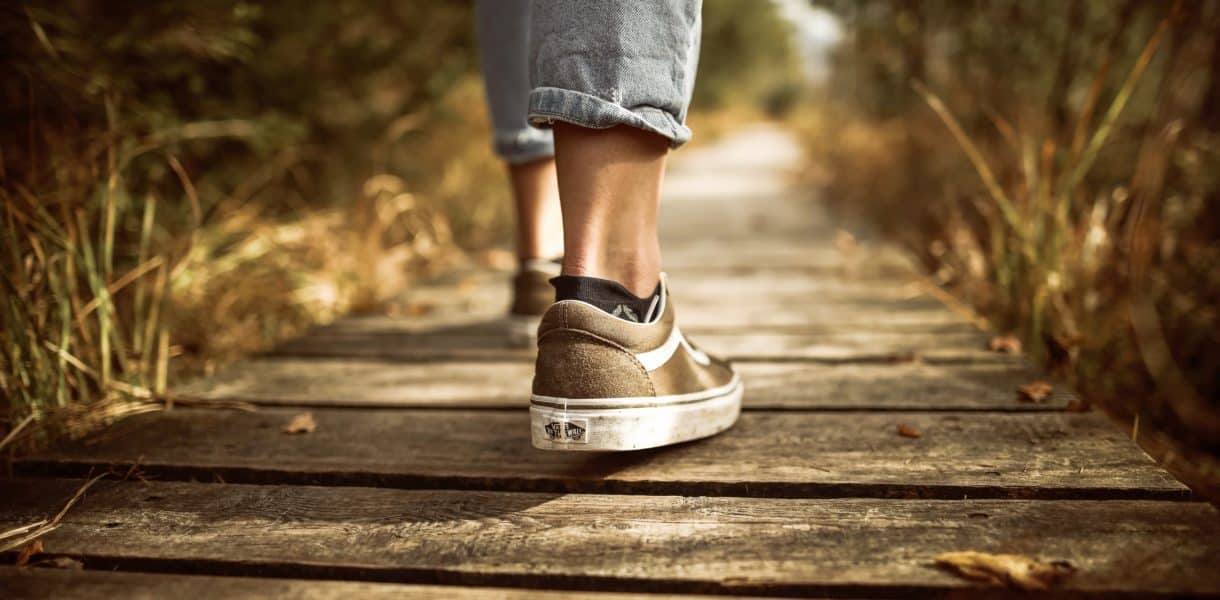We live in stressful and unprecedented times. Whether you’re someone like me who struggles with anxiety and depression, or you’ve been faced with seemingly unfair challenges due to the widespread effects of COVID-19, or you struggle with stress for any other reason, it’s important to have practical ways to cope. One way to cope with stress, anxiety, and depression that’s free and virtually anyone can do is mindful walking.
What is Mindful Walking?
Most of us walk every day and we don’t think anything of it. Whether we’re walking from one place in our homes to the next or taking a walk through the local park, we typically don’t put that much thought into the process of walking. Instead, it’s just something that most of us do automatically. We may think about where we begin, how far we need to walk, and where we want to end up, but we rarely focus on the journey in between.
Mindful walking is a practice where one tries to remain consciously aware of oneself and surroundings while moving from one place to the next, typically in the outdoors. Basically, mindful walking is the simple approach of incorporating mindfulness and meditation into the physical experience of walking. The goal of mindful walking is similar to the goal of any type of mindfulness meditation – to focus on breathing, quiet the mind and racing thoughts, and become fully present at the moment.
The Benefits of Incorporating Mindful Walking Into Everyday Life
There are many physical and mental benefits of both mindfulness and walking, and mindful walking brings all of those benefits together. Of course, walking is good for physical health. It’s a low-impact exercise that gets your body moving. Walking can help you maintain a healthy weight, strengthen your bones and muscles, prevent against or help manage various conditions, and even improve your mood.
On the other hand, mindfulness techniques help promote healthier well-being and self-regulation skills. For example, researchers believe that mindfulness helps promote cognitive awareness, self-esteem, relationship satisfaction, memory, focus, and learning. It can also help reduce stress, anxiety, depression, and symptoms of various mental health conditions by helping people feel clarity and calmness. Mindfulness is also helpful in managing an array of health conditions, ranging from chronic pain to substance use disorder.
A Step by Step Guide to Mindful Walking for Beginners
As you can see, anyone can benefit from walking. Whether you’re feeling extra stressed from work, are in recovery from addiction, suffer from depression, or are feeling anxious about the current state of the world, you should give mindfulness walking a shot. It’s free, and you can do it virtually anywhere as long as you’re outdoors.
Evolve Treatment Center describes a simple mindful walking technique that anyone can try:
- Carve out 20 minutes in your day for a walk around your neighborhood or park. As long as you’re outdoors, you’re good to go.
- Spend the first five minutes walking normally. Try to bring your attention to your body by feeling your feet touch the ground, the muscles in your legs move, and any other physical sensations you can feel. For example, focus on the wind, the temperature, and how the different parts of your body feel as you take each step.
- Spend the next five minutes focusing on the world around you while keeping your gaze at eye-level. While trying to pay attention to everything you see, try and identify five things you have never seen or noticed in that area before. It doesn’t matter if you see street signs, trees, or birds – the only important thing is that you shift your attention away from yourself and onto the world immediately around you.
- Minutes 10-15 should be spent repeating step number three, but with your gaze focused higher than eye level. If you have performed the first three steps correctly, your body will walk for itself so you don’t have to worry about tripping, falling, or losing your balance. Instead, focus on looking up and identifying five things you’ve never seen or noticed before.
- The last five minutes should be spent bringing your attention back to your body just like you did in step number two. Feel your feet, arms, back, legs, and the rest of your body to see how they feel. Identify whether or not anything feels different than it did before, and do so without judgment. After 20 minutes, you can return home.
Once you get back home, identify how you feel, your thoughts, and your overall state of mind. You may notice that you feel more relaxed, energized, or content. This is just one of many mindful walking exercises that are meant to help people get out of their hectic minds, step away from external stressors, and practice accepting life just as it is.
Try Mindful Walking For Yourself Today
It doesn’t matter if you live in the city, the country, or the suburbs – getting outside and practicing mindful walking can help benefit your physical, mental, and emotional health. If a self-guided meditation simply doesn’t cut it, there are numerous apps and online videos that can guide you through walking meditations. So, figure out what it is you want to improve or work on in your life, put on some comfy clothes and supportive shoes, and get outside and start walking. You may be surprised by all of the benefits you see!
If you like this article, check out: https://stories.harnessmagazine.com/identifying-and-managing-anxiety-attacks/






